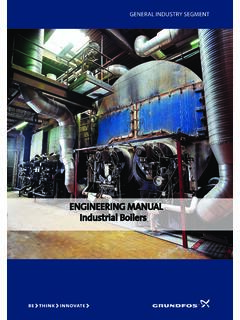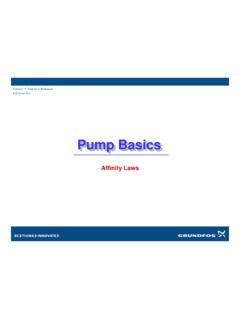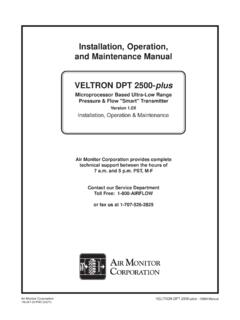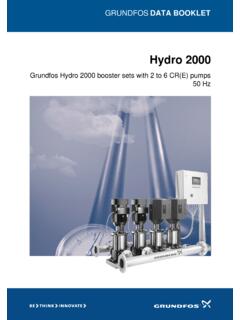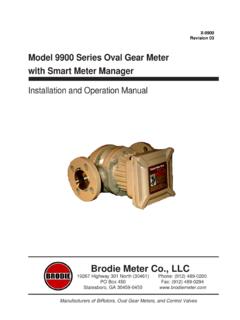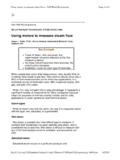Transcription of ENGINEERING MANUAL Industrial Boilers - INSCO …
1 general Industry seGment ENGINEERING MANUAL Industrial Boilers Ver 01. 18/12/2008 Page 1 of 25 general .. 2 Boiler 2 Boiler system .. 4 Boiler components.. 4 Deaerators/Condenser.. 4 6 Economizer in the marine.. 6 Economizers in landbased 7 Boiler 7 Boiler feed.. 7 Condensat pump .. 11 Shunt 12 What Grundfos offers.. 14 Pumps and sizing.. 20 20 Ver 01. 18/12/2008 Page 2 of 25 general . The production of steam and hot water is one of the world s largest industries. Grundfos is pleased to be the preferred supplier of pumps for boiler systems for these industries. Grundfos pumps are reliable, efficient and cover a vide performance range. As an experienced consultant in the implementation of boiler systems, we engage in a process of close partnership and dialogue to find the best solution for your system. Grundfos is a global enterprise with a worldwide service network.
2 When you need export or need on-the-spot advice in a particular part of the world, we have the technical expertise close by. Boiler types. There are three main types of Boilers : Hot water boiler Thermal oil boiler Steam boiler The demands and the sizing of the pumps used for these boiler types are very different. Ver 01. 18/12/2008 Page 3 of 25 1. Hot water boiler Hot water Boilers are normally used in room and process heating. This kind of system is suitable for discharge temperatures up to 140 C. The advantage of hot water over steam is that energy loss is lower than with steam Boilers . 2. Thermal oil boiler In hot oil Boilers is used oil in stead of steam or water. The advantage with oil is that the system does not have to be pressurised above 100 C as with water and steam, but functions in atmospheric pressures of up to 300 C. In contrast, water requires a pressure of 85 bar to avoid evaporating.
3 The construction of thermal oil Boilers and systems is almost identical to that of hot water Boilers . 3. Steam boiler Steam is normally used in Industrial process heating due to its high energy content. Steam is also used for cleaning applications and turbine-generation. The advantage of steam over hot water is its high energy content and ability to release energy during condensation. This also allows for very small heat exchangers. BurneHot water boiler Shunt End Forward Return BurneHot Oil boiler Shunt End Forward Return Ver 01. 18/12/2008 Page 4 of 25 Boiler system Boiler components. Deaerators/Condenser. Deaerator and condenser tanks are only used in steam boiler systems and not in hot water and hot oil boil because here the fluid always is on liquid form. The construction of these two types of tanks is almost identical, but as their names suggest, they are used for different purposes.
4 Two primary principles are used with this form of tank design: thermal and vacuum. Which one depends on which type of boiler being used. Each principle also has different pump construction requirements. Thermo principle A tank using the thermal principle is connected to the atmosphere. This design is normally used in smaller plants. Here, steam is used to maintain tank water temperature at around 105 C, which removes air from the water. Vacuum principle Here, an ejector pump is used to create a vacuum in the tank. This causes the tank water to start boiling because of the low temperature, which in turn removes air from the water. This principle is normally used for steam turbine applications. Return condensate From water treatment Condensate tank Feed pumps Steam boiler Deaerator Level sensor Level sensor Condensate pumps Ver 01. 18/12/2008 Page 5 of 25 Deaerator.
5 A deaerator is used to reduce oxygen (O2) and carbonic acid (CO2) levels in boiler feedwater to protect a boiler against corrosion. It is possible to reduce oxygen and carbonic acid levels to about < mg/l of O2 and 0 mg/l of CO2, depending on deaerator construction. Condenser. A condenser ensures that all steam is condensed before being pumped back into the deaerator and on into the boiler. New treated water is normally fed into the condenser. Ver 01. 18/12/2008 Page 6 of 25 Economizer Historically, economisers have only been used in large-scale power plants. However, the demand for more efficient Boilers within industry and marine means that economisers are now far more commonplace. An economiser is a heat exchanger that is placed in the exhaust from a boiler or in the exhaust funnel of the main engine of a ship. Pump requirements differ greatly, depending on where the economiser is installed.
6 Economizer in the marine. Referring to the diagram below, the circulation pump has to be sized to the pressure and temperature in the boiler, which can easily be 20 bar and 170 C. Because of this, economisers featuring air-cooled top and bearing flange may be required. The pump does not normally need to be capable of delivering a high differential pressure, as it only has to overcome the pressure loss in the plate heat exchanger (economiser). BurneDeaerator BoileSteaFeed CondensatSmoke to chimneyCirculation EconomizeSmoke from main engine Ver 01. 18/12/2008 Page 7 of 25 Economizers in landbased Boilers . An economiser used with a boiler located on land uses the boiler s waste gases. The water circulated over the economiser is normally supplied by the main feed pump, but can also be fitted with its own circulation pump. The chimney will also include a bypass to allow waste gases to pass around the heat exchanger.
7 The construction differs from marine design as the waste gases released from the main engine of a ship is significantly greater. Energy produced by marine applications often allow for the generation of overheated steam fed directly from economiser and out in the piping. Boiler pumps. A range of pumps for different boiler applications exist. This section describes typical positioning of the different pumps and how they are controlled. The most common boiler applications are boiler feed, condensate pumping, economiser circulation and shunt pumps. Sub system pumps such as dosing and water treatment pumps also exist. Boiler feed. When we talk boiler feed there is normally 4 ways to do it. On/off control Via feed valve Via feed valve and variable speed Variable speed They will all be described underneath here. Burner DeareatBoiler SteamFeed pump Condensate Smoke from boilerSmoke to chimney Ver 01.
8 18/12/2008 Page 8 of 25 1. On/off control Function In on/off control the feed pump is switched on/off via a level sensor or a differential pressure sensor. When the water level falls to the Pump on level, the pump starts pumping a large quantity of relatively cold water into the boiler. This will reduce the quantity of steam and cause the steam pressure to fall. This is the reason why on/off control causes variations in steam production. It may also cause over-boiling in the boiler, which may cause water to enter into the system. Benefits > Inexpensive > Simple to install > No bypass 2. Via feed valve. Function In this type of system the water level in the boiler is controlled by a feed valve, which is controlled by a level sensor or a differential pressure transmitter positioned on the boiler. The feed valve controls the water intake, which is adjusted according to steam consumption.
9 This, however, requires that the feed pump is set to continuous operation. This system operates smoothly and is ideal for all types of steam Boilers , both small and large, and will minimise the risk of over-boiling. Benefits > Boiler feeding adjusted according to steam consumption, as described. Feed pumpsSteam boilerDeaeratorBypassLevel sensorFeed pumpsSteam boilerDeaeratorLevel sensor Ver 01. 18/12/2008 Page 9 of 25 Drawbacks > The pump must be set to continuous operation (energy consumption) > Bypass > Feed valve is expensive > Pressure loss across feed valve Important Remember to size bypass according to the CR data as to min. flow. It may be an idea to stop the pump at closed valve. This requires, however, a signal from the valve. 3. Via feed valve (variable speed) Function In this system the water level in the boiler is controlled by a feed valve, which is controlled by a level sensor or a differential pressure transmitter positioned on the boiler.
10 The feed valve controls the water intake, which is adjusted according to steam consumption. This, however, requires that the feed pump is set to continuous operation. This system operates smoothly and is ideal for all types of steam Boilers , both small and large, and will minimise the risk of over-boiling. Benefits > Boiler feeding adjusted according to steam consumption. > Energy savings on pump operation. > Constant differential pressure across feed valve Drawbacks > Bypass > Feed valve is expensive > Pressure loss across feed valve Important Requirements vary from one country to another as to the sizing of boiler feed pumps. Remember to size bypass according to the CR/CV data as to min. flow. It may be an idea to stop the pump at closed valve. This requires, however, a signal from the valve. Find out whether variable speed control of both pumps is required, as this increases expenses, but does not provide the same flexibility as to alternating pump operation.
